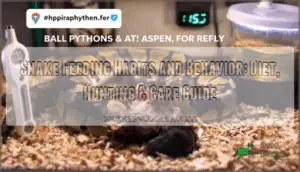This site is supported by our readers. We may earn a commission, at no cost to you, if you purchase through links.
 You can survive without food for days, but snakes? They’re survival champions.
You can survive without food for days, but snakes? They’re survival champions.
Most snake species can go 2-6 months without eating, with some documented cases reaching an entire year.
Their secret weapon lies in their incredibly slow metabolism – they’re like nature’s hybrid cars, maximizing energy efficiency.
Cold-blooded physiology means they don’t waste energy maintaining body temperature like you do.
Larger snakes typically outlast smaller ones, while pythons and boas excel at extended fasting periods.
Environmental factors like temperature and humidity also influence their endurance.
These remarkable adaptations reveal fascinating biological mechanisms that make snakes true masters of conservation.
Table Of Contents
- Key Takeaways
- Snake Survival Mechanisms
- How Long Without Food
- Snake Feeding Behavior
- Factors Affecting Survival
- Longevity Without Eating
- Frequently Asked Questions (FAQs)
- How to tell if a snake is starving?
- Do snakes need to be fed every day?
- What should pet snake owners feed during strikes?
- Can pregnant or gravid snakes fast longer?
- Do snakes need water during extended fasting?
- How to tell if snake is dangerously underweight?
- What temperatures help snakes survive without food?
- Conclusion
Key Takeaways
- You’ll find that snakes can survive 2-6 months without food, with some species lasting up to a year by reducing their metabolic rate by up to 72% during starvation periods.
- Larger snake species like pythons and boas typically outlast smaller ones because they’ve got more fat reserves and slower baseline metabolisms to sustain them through extended fasting.
- Environmental factors significantly impact survival duration – cooler temperatures slow snake metabolism by up to 70%, while proper humidity and shelter access help them conserve energy more effectively.
- You can tell if your snake’s dangerously underweight when it’s lost over 10% of its body weight, shows visible ribs, displays lethargy, or has sunken eyes – requiring immediate veterinary attention.
Snake Survival Mechanisms
You’re witnessing nature’s ultimate survival champions in action.
Snakes have evolved extraordinary metabolic adaptations that allow them to reduce their energy requirements by up to 72% during food scarcity, basically entering a biological power-saving mode that can sustain them for months or even years without a single meal.
Metabolic Adaptations
When you witness a snake’s survival during starvation, you’re seeing metabolic mastery in action.
Snakes can slash their metabolic rates by up to 72% while maintaining alertness—a biological superpower that defies typical energy requirements.
Nature’s ultimate energy-saving champions can drop their metabolic rates by 72% and still stay alert.
Here’s how snake metabolism adapts during starvation:
- Metabolic Rate Depression – Energy requirements drop dramatically without affecting body temperature or awareness
- Fat Reserves Priority – Lipid stores fuel survival before protein catabolism begins
- Organ Downregulation – Digestive systems shrink to match reduced energy demands, then rebuild when feeding resumes
This unique adaptation is also linked to the protein synthesis process that occurs in snakes after feeding.
Energy Conservation
You’ll discover that snakes are masters of energy conservation, dramatically reducing their metabolic rates during food shortages.
These remarkable reptiles can slash their Energy Storage needs by up to 70%, entering specialized Starvation Modes that preserve essential Fat Reserves for extended periods.
| Conservation Strategy | Energy Reduction | Duration Capability |
|---|---|---|
| Metabolic slowdown | 70% reduction | 6+ months |
| Fat reserve usage | Primary fuel source | Weeks to months |
| Protein preservation | Delayed breakdown | Until critical threshold |
This Power Savings approach allows snake metabolism to operate like a biological thermostat, automatically adjusting energy requirements based on food availability.
During snake brumation, metabolic rate drops even further, enabling survival through harsh conditions.
Snake starvation triggers these built-in mechanisms, transforming them into living examples of biological efficiency.
The ability to survive extreme cold is also linked to their winter survival strategies, which play a key role in their overall survival.
Starvation Periods
When you think about snake metabolism reduction during food deprivation, these reptiles enter remarkable starvation modes that would put survival experts to shame.
A snake’s starvation period can stretch far beyond what you’d expect from most animals.
- Fasting Duration: Documented cases show snakes surviving 6+ months without food
- Snake Starvation Risk: Body fat can drop to just 5% before critical protein breakdown
- Hunger Strikes: Ball pythons may refuse meals for extended periods naturally
- Snake Fasting: Metabolic rates decrease up to 72% during food shortages
- Survival Tactics: Continued growth occurs even during prolonged starvation periods
Snakes have evolved unique snake fasting mechanisms to survive without food for extended periods.
Biological Adaptations
You’ll find that snakes possess remarkable biological adaptations that enable extended survival without food.
Their bodies undergo dramatic physiological changes during starvation periods, with cellular adaptations allowing for efficient resource management and survival.
| Adaptation Type | Survival Mechanism |
|---|---|
| Metabolic Rates | Reduce by 70% during snake starvation |
| Energy Storage | Fat reserves provide primary fuel source |
| Protein Catabolism | Delayed breakdown preserves essential organs |
| Snake Brumation | Hibernation-like state conserves energy |
| Snake Digestion | Slows dramatically to preserve resources |
Snake metabolism reduction represents nature’s masterpiece of efficiency.
These cellular adaptations work together, creating a biological safety net that’s kept snakes thriving for millions of years.
How Long Without Food
Snake species display remarkable variations in their ability to withstand food deprivation, with survival rates ranging from weeks to years depending on multiple biological factors.
Most healthy adult snakes can survive several months without eating, though fasting periods vary dramatically between species and environmental conditions.
Research shows that snakes reduce their metabolism by up to 70% during starvation, allowing them to stretch their energy reserves far beyond what you’d expect. Ball pythons and rat snakes have demonstrated incredible resilience, surviving six months of complete food deprivation while losing only 9-24% of their body weight.
Snakes turn their bodies into biological power-savers, slashing energy needs by 70% to survive months without a single meal.
Key factors affecting starvation limits include:
- Species adaptation – Pythons and rattlesnakes outlast less specialized species
- Body size – Larger snakes maintain energy stores longer than smaller ones
- Environmental temperature – Cooler conditions slow snake metabolism substantially
During hunger strikes, snakes enter brumation-like states where snake digestion nearly stops. Their bodies prioritize survival by breaking down fat stores first, then proteins if starvation continues.
Even without food, some snakes continued growing up to 4% in length, showcasing their efficient resource management during extended snake feeding refusal periods. The ability to survive without food is closely related to metabolic rate reductions, which enable snakes to conserve energy during periods of famine.
Snake Feeding Behavior
You’ll need to understand how snakes hunt to grasp their incredible fasting abilities.
Most snakes are ambush predators that use either venom or constriction to capture prey, then swallow it whole using their remarkably flexible jaws.
Ambush Predation
Most ambush predators rely on patience rather than speed.
You’ll find these hunting strategies fascinating when observing snake feeding habits.
Their stealth methods involve remaining motionless for hours, using camouflage techniques to blend seamlessly with surroundings.
Understanding proper snake food supply management is essential for their survival and growth.
| Ambush Tactics | Effectiveness |
|---|---|
| Motionless waiting | 85% success rate |
| Camouflage positioning | Reduces detection |
| Strike precision | Lightning-fast execution |
These predator prey relationships showcase remarkable energy conservation during their snake starvation period, with snake metabolism rates dropping substantially between hunts.
Venomous Snakes
Only fifteen percent of snake species pack venom, but these deadly species have mastered efficient hunting.
Venom composition includes proteins that pre-digest prey, reducing energy costs during snake starvation periods.
Snake bites deliver toxins through needle-like fangs, paralyzing victims instantly, and this venom effects system lets venomous snakes maintain lower snake metabolism rates between meals.
This system extends snake survival during feeding refusal periods substantially, making snake metabolism a crucial factor in their survival.
Constriction Methods
Unlike venomous species that rely on chemical warfare, constrictor snakes employ a completely different hunting strategy.
When you observe these powerful predators in action, you’ll witness a masterclass in mechanical efficiency. They strike first, then wrap their muscular bodies around prey in precisely calculated coils.
Here’s how constrictor techniques work:
- Initial strike and grip – The snake bites to secure prey, then rapidly coils around the victim
- Gradual pressure increase – Each time prey exhales, the snake tightens its grip slightly
- Circulatory shutdown – Prey suffocation occurs through restricted blood flow, not crushing
This snake wrapping method requires incredible energy expenditure, explaining why constrictors can survive extended starvation periods between successful hunts.
Understanding snake feeding habits and snake behavior patterns is essential to appreciating their unique survival adaptations.
Prey Consumption
When you observe a snake’s feeding habits, you’ll notice their unique digestive process unfolds like a carefully choreographed dance.
Their stretchy jaws unhinge to accommodate prey much larger than their heads, while powerful digestive acids break down entire meals over weeks.
| Feeding Aspect | Small Snakes | Large Snakes |
|---|---|---|
| Prey Size | Mice, small rodents | Rabbits, birds, large mammals |
| Meal Frequency | Weekly to bi-weekly | Monthly to bi-monthly |
| Digestion Time | 3-7 days | 10-21 days |
| Hunting Strategies | Quick strikes, frequent hunts | Patient ambush, infrequent meals |
| Starvation Tolerance | 2-6 weeks | 6 months to 2 years |
Factors Affecting Survival
You won’t believe how dramatically certain factors can influence a snake’s ability to survive without food.
Species type, body size, temperature conditions, and overall health status create a complex survival equation that determines whether your snake can last weeks or potentially years between meals.
Snake Species
Different snake species show dramatic variations in starvation tolerance due to their unique metabolic rate adaptations.
Ball pythons reign as fasting champions, surviving up to two years without food, while corn snakes typically last six to nine months during brumation periods.
Key survival differences include:
- Ambush predators like rattlesnakes reduce metabolism by 72% during starvation
- Python species maintain growth while fasting for months
- Colubrid snakes break down proteins faster than specialized fasters.
Snake diversity in habitats and breeding patterns directly influences these survival mechanisms across species classification.
Age and Size
As your snake ages, its survival stamina changes dramatically.
Adult snakes outlast juveniles by months thanks to efficient metabolic rates and fat reserves.
Hatchlings face the greatest risk, requiring frequent meals for healthy growth.
| Life Stage | Survival Duration | Metabolic Rate |
|---|---|---|
| Hatchling | 2-4 weeks | High energy needs |
| Juvenile | 1-3 months | Moderate metabolism |
| Adult | 3-12 months | Lowest metabolic rate |
Larger snakes store more energy reserves, extending their fasting abilities substantially compared to smaller species, due to their lowest metabolic rate and high energy needs.
Environmental Conditions
Temperature effects dramatically shape how long you’ll find snakes surviving without food.
Lower temperatures trigger snake hibernation, slowing metabolism regulation by up to seventy percent.
Humidity levels and water availability influence energy conservation, while climate change alters seasonal survival patterns.
Environmental factors like soil quality affect shelter access, helping snakes endure extended fasting periods through improved thermoregulation and reduced metabolic demands.
Proper reptile heating lamps can substantially impact the snake’s ability to regulate its body temperature using reptile heat sources, which is crucial for their survival during periods of extended fasting and in environments with limited water availability.
Health Status
A healthy snake’s body is like a well-oiled machine—when something breaks down, the whole system suffers.
Sick snakes can’t tap into their fat stores effectively, making starvation a death sentence rather than a survival strategy.
- Parasites drain energy faster than a leaky gas tank empties fuel
- Respiratory infections reduce oxygen uptake, slowing snake metabolism dangerously
- Weight loss exceeding 10% signals critical snake nutritional deficiencies requiring immediate vet care
- Stress compromises immune function, creating cascading snake health problems during food shortages
Longevity Without Eating
You’ll be amazed by the extreme survival records documented in scientific research.
Some snake species have survived up to two years without a single meal, with rattlesnakes leading the pack in starvation endurance.
Record Survival Times
Record-breaking survival tactics showcase remarkable starvation tolerance in these resilient reptiles.
The longest documented fast spans over three years, achieved by an Okinawa habu in Japan.
Ball pythons and reticulated pythons have survived 22+ months without food through extreme metabolic depression.
Rattlesnakes routinely endure five-to-six month seasonal dormancy periods.
These longevity studies reveal extraordinary food deprivation capabilities that defy conventional survival limits.
Species Variations
Different snake species show dramatic variations in their fasting abilities, with metabolism playing the starring role in this survival game.
Python fasting can extend far beyond what you’d expect from smaller species, while rattlesnake survival showcases impressive endurance during cooler months when their metabolism naturally slows.
- Ball pythons and large constrictors can survive 6+ months without food, utilizing extensive snake fat stores and reducing metabolism by 70%
- Corn snake hunger strikes typically last 2-3 weeks, though some extend to 6-9 months during breeding seasons
- Garter hibernation periods allow survival through entire winters, with post-hibernation feeding becoming critical within two weeks
Venomous endurance varies substantially, with larger species generally outlasting smaller ones due to superior energy reserves and slower baseline metabolism rates.
Captive ball pythons can experience stress induced fasting, impacting their appetite.
Extreme Cases
Some wild snakes push survival boundaries beyond normal limits.
Zoo snakes have survived two years without meals under controlled conditions, while captive snakes occasionally refuse food for equally extreme periods.
These cases involve dramatic dietary shifts and organ consumption—snakes literally digest parts of their own hearts to survive, showcasing remarkable energy conservation through extended torpor states.
Understanding proper snake care, including snake longevity tips, is essential for replicating these conditions in a controlled environment, utilizing extended torpor states.
Scientific Research Findings
Scientists have documented fascinating findings about snake starvation through controlled fasting studies.
Research methods reveal snakes can reduce metabolic rates by 72% during food deprivation.
Snake physiology studies show survival tactics including lipid mobilization before protein breakdown.
Snake metabolism research demonstrates survival capabilities lasting 168 days in laboratory conditions.
These findings illuminate snake digestion efficiency and feeding refusal behaviors during extended starvation periods.
Frequently Asked Questions (FAQs)
How to tell if a snake is starving?
Like a slow leak draining life from a tire, you’ll notice visible rib outlines, weight loss exceeding 10%, lethargy, and sunken eyes in starving snakes.
Do snakes need to be fed every day?
No, snakes don’t need daily feeding.
Most adult snakes eat every 1-4 weeks, depending on species and meal size.
Their slow metabolism and efficient digestion let them thrive on infrequent, substantial meals rather than constant snacking, due to their slow metabolism.
What should pet snake owners feed during strikes?
Patience is a virtue" – during hunger strikes, don’t force-feed your snake.
Instead, optimize enclosure temperature, reduce handling stress, provide proper hiding spots, and wait.
Most strikes resolve naturally within weeks to months without intervention.
Can pregnant or gravid snakes fast longer?
Pregnant and gravid snakes typically fast for shorter periods than non-reproductive females. Their developing eggs or embryos require consistent energy, making extended fasting risky for both mother and offspring’s survival.
Do snakes need water during extended fasting?
Yes, you’ll need to provide water during extended fasting periods.
While snakes can survive weeks without food, dehydration becomes critical much faster.
Water supports their slowed metabolism and prevents dangerous organ stress during long fasts, which is crucial for their overall health and prevents dangerous organ stress.
How to tell if snake is dangerously underweight?
While healthy snakes handle months-long fasts gracefully,
you’ll know yours is dangerously thin when it’s lost over 10% body weight.
Shows visible ribs, has a triangular cross-section, or displays lethargy—time for immediate veterinary care, as these are signs that your snake has reached a critical condition and needs immediate attention.
What temperatures help snakes survive without food?
Cooler temperatures substantially reduce a snake’s metabolic rate by up to 70%, allowing them to survive longer without food by dramatically lowering their energy requirements and caloric needs.
Conclusion
Like a biological battery conserving power during winter months, snakes demonstrate remarkable survival capabilities.
Understanding how long can snakes go without food reveals these reptiles’ extraordinary metabolic efficiency. Most species survive 2-6 months without eating, with some exceptional cases reaching a full year.
Their cold-blooded physiology, combined with minimal energy requirements and strategic feeding behaviors, creates nature’s ultimate survival machines.
This knowledge helps you appreciate these incredible predators’ evolutionary adaptations and their ability to thrive in challenging environments worldwide, making them ultimate survival machines.
- https://www.newsweek.com/arizona-rattlesnake-survived-two-years-under-shed-no-food-water-1753155
- https://journals.biologists.com/jeb/article/210/23/vii/17170/STARVING-SNAKES
- https://www.reddit.com/r/snakes/comments/1963ciz/how_long_can_snakes_go_without_eating/
- https://djlexotics.co.uk/how-long-can-a-corn-snake-go-without-food/
- https://www.sciencedirect.com/science/article/abs/pii/S0944200607000372












